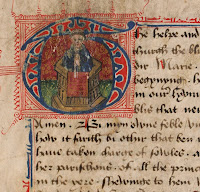Middle English

1. Approximately when was Middle English spoken?
Middle English was spoken between the late 11th century up to appriximately the 16 century.
2. What were the major factors which led to the development and the spread of Middle English?
The diversity of forms in written Middle English may signify neither greater variety of spoken forms of English than could be found in pre-Conquest England, nor a faithful representation of contemporary spoken English.This diversity suggests the gradual end of the role of Wessex as a focal point and trend-setter for scribal activity, and the emergence of more distinct local scribal styles and written dialects, and a general pattern of transition of activity over the centuries that follow.
3. Match the following Old English words with their Anglo-Norman equivalent:
A. Pig = Pork
B. Cow = Beef
C. Wood = Forest
D. Sheep = Mutton
E. House = Mansion
F. Worthy = Honourable
G. Bold = Courageous
4- Compare & contrast the structure of nouns, pronouns and verbs, between Middle English & Modern English.
The contrast of these kind of words is that they are simplified , the grammar of Middle English is much closer to that of modern English than that of Old English. Compared to other Germanic languages, it is probably most similar to that of modern Dutch.
5-How is pronunciation different between Middle English and Modern English?
All letters in Middle English words were pronounced. (Silent letters in Modern English come from pronunciation shifts, which means that pronunciation is no longer closely reflected by the written form.) Therefore 'knight' was pronounced [kniçt] (with a pronounced
6- What is the Chancery Standard, and how did it come into effect?
Chancery Standard was a written form of English used by government bureaucracy and for other official purposes from the late 15th century. It is believed to have contributed in a significant way to the development of the English language as spoken and written today. Because of the differing dialects of English spoken and written across the country at the time, the government needed a clear and unambiguous form for use in its official documents. Chancery Standard was developed to meet this need.
7. Who wrote the Canterbury Tales?
Geoffrey Chaucer at the end of the 14th century.
8. Describe the medieval pilgrims who journeyed from Canterbury to London.
The pilgrimage was a very prominent feature of medieval society. Pilgrims would frequently journey to cathedrals that preserved relics of saints. They believed that such relics had miraculous powers. Pilgrimages also represented the mortal journey to heaven through the struggles of mortal life.
9. Why did the pilgrims take this journey?
They wend their way to Canterbury from every shire of England to seek the holy blessed martyr, Thomas Becket, who has helped them when they were sick.
10. It is thought that some of the stories in The Canterbury Tales originated in Italy. What was the name of the Italian book and who wrote it?
The Canterbury Tales were written in Middle English, specifically in a dialect associated with London and spellings associated with the then emergent chancery standard. Although no manuscript of the Tales exists in Chaucer's own hand, two were copied around the time of his death by Adam Pinkhurst.
11. The Canterbury Tales is considered an extremely important book, both in terms of English Literature & in the history of English writing. In your opinion, why is this book so important?
It's important because it gave to the English Language, the main root of words from Old English to now. Beside that The Canterbury Tale contributed in terms of culture and history.
12. Sir Gawain and the Green Knight is:
It is a detailed explanation of the proper etiquette & behaviour for all knights in Medieval Europe.
13. Who is Sir Gawain?
He was a knight of King Arthur´s round table.
14. What is the challenge that The Green Knight proposes to the Knights of the Round Table?
The Green Knight offers to allow anyone to strike him with his axe if the challenger will take a return blow in a year and a day.
15. What is the similarity between Sir Gawain and the Green Knight and the Irish tale of Cúchulainn?
In this Irish tale of Cúchulainn parallels Gawain in that, like The Green Knight Cú Chulainn´s antagonist feints three blows with the axe before letting his target depart without injury.
16. What is the importance of the pentagram/pentangle in the poem?
The pentagle symbolizes the virtues to which Gawain aspires such as to be faultless in his five senses; never to fail in his five fingers; to be faithful to the five wounds that Christ received on the cross; to be strengthened by five joys that the Virgin Mary had in Jesus; and to possess brotherly love, courtesy, piety, and chastity.
The importance of the pentangle in this poem is that.
17. How are numbers used to symbolize events in the poem?
The poet highlights number symbolism to add symmetry and meaning to the poem.
18. What is the significance of Sir Gawain's neck wound?
Gawain´s wound is an outward sign of an internal wound.
19. Which actor played The Green Knight in the film adaptation, Sword of the Valiant?
Tha actor who played The Green Knight in that film was Sean Connery.
20. In many ways this poem is, in the modern sense, a soap opera. Compare Sir Gawain and the Green Knight with a modern Chilean teleseries.
I can compare this poem with Miguel Carrera soap opera which is a Chilean teleserie, fighting for all those values or virtues encountered in Sir Gawain and The Green Knight poem.



Comentarios
Publicar un comentario